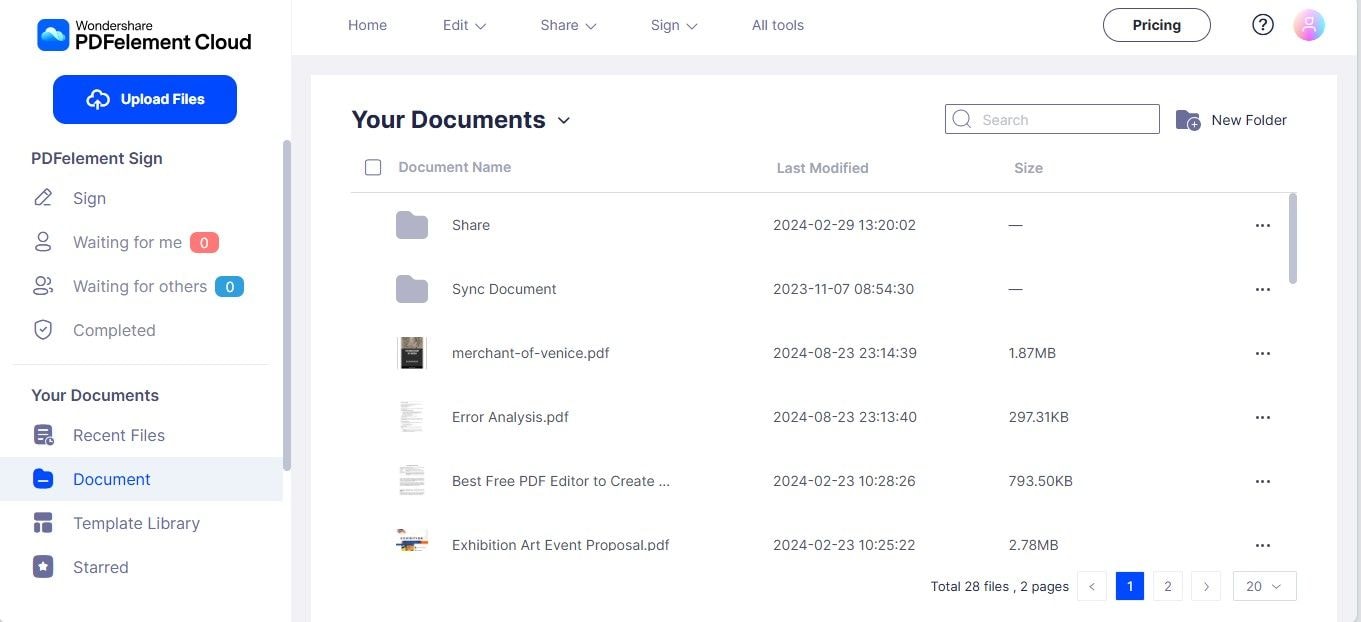
Imagine you're in the middle of an important project and need the most recent versions of your documents at your fingertips. Instead of sending files individually to each device, you can upload them to a cloud storage platform for seamless access. This is where cloud-based PDF management becomes essential. Storing your PDF in cloud not only makes files accessible but also syncs the recent changes made to those files.
Out of the multitude of Cloud document management tools, Adobe Acrobat DC Cloud offers a seamless storage solution. The platform allows you to create, edit, and share PDFs across all your devices with ease. In this connection, this guide will explore what Adobe Document Cloud is, how to use it, and its reliability as a cloud platform.
In this article
Insights Into Adobe Document Cloud - PDF Cloud Storage Platform

Adobe Acrobat Pro Document Cloud (DC) is a cloud-based platform by Adobe that allows you to create, edit, and sign PDF documents from anywhere. It integrates Adobe's powerful PDF tools with cloud storage. Using Document Cloud, you cannot only create & edit PDFs but also share them seamlessly across multiple devices. Whether you use a desktop, tablet, or smartphone, Adobe DC Cloud ensures that your documents are always up-to-date and accessible from whatever device or OS you use.
| Specification | Description |
| Price |
|
| Compatibility | Windows 10, Windows 11, MacOS, Android, iOS |
| Supported File Type | PDFs, Documents, Images, Forms, & more |
| Best For | Professionals & Businesses needing advanced PDF editing, e-signatures, and secure document management |
| Offline File Access | Yes |
| Collaboration | Real-time collaboration with Adobe Acrobat, Adobe Sign, and other Adobe Document Cloud services |
| Version History | Up to 100 versions, retained for 30 days |
| External Integrations | Adobe Creative Cloud applications (Photoshop, Illustrator, InDesign, etc.), Microsoft 365 applications, and third-party services like Dropbox, Google Drive, and OneDrive |
Key Features of Adobe Pro DC Cloud
Below are some salient features of Adobe Acrobat Document Cloud:
| Feature | Description |
| PDF Editing and Conversion | Easily convert files to and from PDF format and edit text & images directly within your PDFs. |
| E-Signatures | make paperwork a breeze by sending, signing, tracking, and managing electronic signatures. |
| Cross-Platform Compatibility | Access your files from whatever device you use, anywhere, anytime. |
| Adobe Scanner Cloud | Scan documents directly from your mobile and save them in the cloud for seamless access. |
| Secure Sharing | Share files securely via Adobe's cloud and benefit from options to track views, restrict access, and more. |
What's the Difference Between Adobe Document Cloud and Adobe Acrobat DC?
Although used interchangeably, Adobe Document Cloud and Adobe Acrobat DC slightly differ in their functions. Adobe Document Cloud is an overarching term that refers to the entire suite of cloud-based services offered by Adobe. It includes managing, storing, and sharing documents via the cloud. For example, Adobe Document Cloud encompasses tools like Adobe Sign for e-signatures, Adobe Scan for scanning documents, and cloud storage for accessing files from any device. In short, it's a comprehensive ecosystem for document management.
On the other hand, Adobe Acrobat DC is a specific software application within the Adobe Document Cloud. It focuses on providing powerful tools for creating, editing, converting, and managing PDF files. While Acrobat DC is a critical component of the Adobe Document Cloud, the latter encompasses a broader range of services beyond just PDF management.
How to use Adobe Document Cloud?
Let's learn to use Adobe PDF Cloud, manage files, and perform different operations in detail:
Step 1
Visit the Adobe website and sign up for an account. If you already have an Adobe ID, simply sign in.
Step 2
Now, you can upload documents to Adobe Document Cloud directly from your web browser or through the Adobe Acrobat DC application. To do so, click on the "Upload" button.

Step 3
To perform operations like editing, commenting, or conversion, navigate to the "Menu" bar.

Pros & Cons of Adobe Acrobat Document Cloud
Like all other tools, Adobe Document Cloud carries certain good and bad points that need to be highlighted. Below is an honest take on the strengths and weaknesses of the tool:
PDFelement Cloud: A Better Alternative to Adobe Document Cloud
No doubt, Adobe Document DC Cloud offers a comprehensive spectrum of tools for document management. However, it comes with certain drawbacks, such as high costs, complexity, and limited storage for low-tier plans. If you're seeking a more affordable and efficient alternative, PDFelement Cloud stands out as a compelling option.
PDFelement Cloud provides many of the same essential features as Adobe Document Cloud but at a relatively low cost. The platform is less demanding on system resources, ensuring smoother performance even on older devices or less powerful devices.
Why Choose PDFelement Cloud?
PDFelement Cloud is a haven of seamless document management, providing users with various benefits, some of which include:
- Provides storage up to 1 GB for free, accommodating your basic document storage needs.
- Offers an intuitive and easy-to-navigate interface, reducing the learning curve for new users.
- Provides robust features for editing, annotating, converting, and merging PDFs, covering all essential document management needs.
- Supports multiple platforms, including Windows, macOS, iOS, and Android, allowing seamless access and synchronization of documents across devices.
- Facilitates collaboration by allowing multiple users to edit, comment, and share documents in real time.
- Provides flexible subscription options tailored to different needs, whether you're an individual user or part of a team.
How to Use PDFelement Cloud for Document Management?
Below is the detailed procedure to manage files via PDFelement Cloud:
Step 1
Access PDFelement Cloud. Sign in to get started.
Step 2
Click "Upload Files" to import and save files for storage.

Step 3
Now, you can edit, convert, compress, sign, share, and perform other operations on your files.

Tips to Maintain a Well-Organized Cloud Environment
No matter which cloud platform you use, whether Adobe Document Cloud or PDFelement Cloud, cluttered files will always create a mess and take extraordinary storage. Thus, you will end up in a colossal heap of files with no trace of organization. To avoid such a condition, it's necessary to adopt effective file management strategies. Some are given below:
Organize Files
Create a well-structured folder system within your cloud storage to keep your documents organized. This makes it easier to locate files quickly and manage multiple projects efficiently.
Compress Files
Use the PDF compression feature to reduce the file size of your documents without compromising quality. This is especially useful for large files with images or graphics, helping you save significant cloud storage space.
Consistent Naming Convention
Establish a clear and consistent file naming system for your documents. Use descriptive names that include dates, project names, or categories. This makes it easier to locate specific files quickly.
Regular Backups
Regularly back up important files to another location as an additional safety measure. This practice keeps your important data secure and accessible.
Delete Redundant Files
Schedule regular audits of your cloud storage to review and clean up unnecessary files. Deleting outdated or redundant documents helps free up space and keeps your storage organized.
Conclusion
Cloud document management platforms enable easy access to your files from anywhere, seamless collaboration, and secure storage. To store your PDFs, Adobe Cloud is a robust solution that provides a wide range of advanced features. However, its expensive pricing structure makes it challenging for individual users to leverage its features.
Thus, if your concern is affordability with the same benefits as Adobe Document Cloud, we recommend using PDFelement Cloud. It offers similar features with a simpler interface and lower cost, making it ideal for individuals and small businesses. Whether you opt for Adobe Document Cloud's professional approach or PDFelement Cloud's affordability, the choice is yours.




